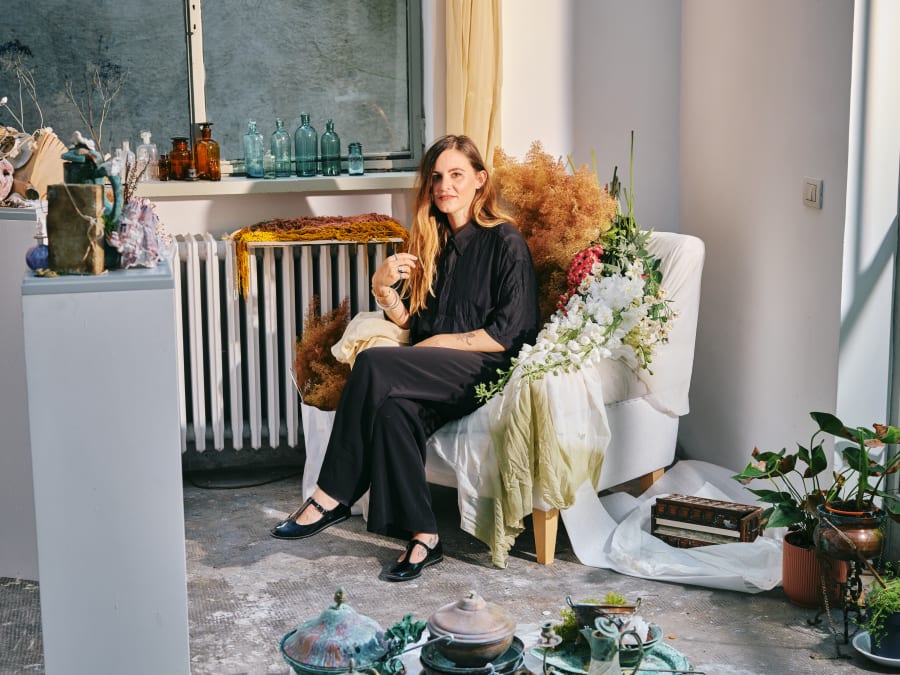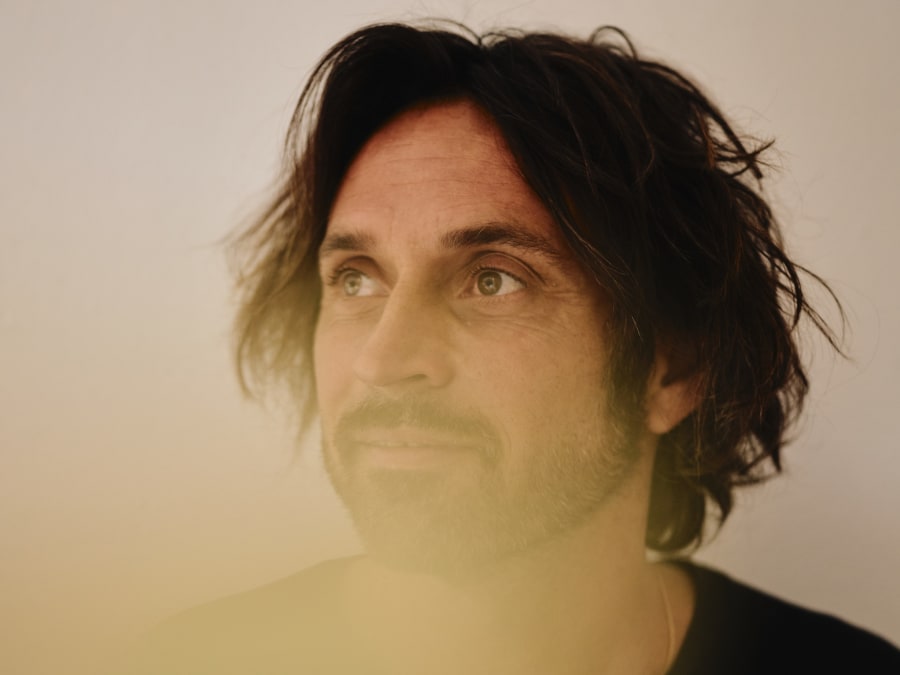In collaboration with the Centre Pompidou
It’s hard to describe with any precision the diffuse bodies floating across the seven canvases bathed in green. Radiating an almost phosphorescent light amid their leafy setting, Xie Lei’s silhouettes are all caught, according to their author, in the same action: free fall. Painted for the 25th edition of the Prix Marcel Duchamp, the series, shrouded in mystery, raises questions. What if these effervescent, haloed-bodies with languorous limbs, whose flesh seems to subtly dissolve into the void, are not approaching the ground, but instead rising from it?
For nearly 20 years now, Xie has been perfecting his rendering of ambiguity – a ‘poetics of the strange,’ as he defines it, speaking from his studio in southern Paris. Whether reduced and intimate, favoring a close-up framing of ghostly bodies and faces, or more monumental, placing the figures in often deep, empty settings, his canvases generally offer at least two distinct interpretations. When a dark head embraces another lighter one (Encounter I, 2022), what appears to be a passionate kiss could equally be an act of suffocation, or even a vampiric aspiration of the soul. When two standing figures embrace (Protection I, 2024), the more incandescent of the two could just as easily evaporate and flee, as offer up it its divine presence within its partner’s arms. As for the figures in free fall that will soon grace the walls of the Musée d’Art Moderne de Paris in September, the artist himself situates them between ‘the tightrope walker and the sleepwalker.’ These humans, depicted by Xie, whose features as well as gender are rarely identifiable, shift between two worlds.
Born in Huainan, the artist studied graphic and pictorial arts from a young age, completing his training with five years at the École des Beaux-Arts in Paris followed by a doctorate (SACre). While he learned a great deal from this rich academic journey, and does not hide his passion for the great masters of classical Western painting – Eugène Delacroix, Philippe de Champaigne, Diego Velázquez, and Francisco Goya – he nevertheless frees himself from its conventions by leaving as much room as possible to his imagination. ‘I never work with living models. At the beginning, I collected many images – from newspapers, magazines, the Internet – for inspiration, but this is less and less the case. Rather, my subjects are chimeras, combinations of elements drawn from my memory. Banal scenes where something extraordinary always happens,’ he summarizes.
By forming these ‘mental images’ on canvas, the painter expresses his desire for an approach that is ‘as universal as possible.’ ‘It’s this ambiguity of content,’ he adds, ‘that, paradoxically, gives the work its meaning.’ In its simplest form, this is evident in the absence of details characterizing his bodies, but also their unnatural colors – yellows, watery greens, blues – and the fade effect that dilutes their carnal materiality. Xie completes this approach by titling his works with single words referring to concepts, archetypes, or simple actions: ‘embrace’, ‘breath’, ‘possession’, ‘rescue’, and so on. Some are even borrowed from French literature, including from authors such as Albert Camus and Jean Genet, whom he particularly admires. A great bibliophile, the painter also notes among his references the texts of psychoanalyst Julia Kristeva and Chinese writers Zhuang Zhou and Pu Songling.
Sleep is where the painter finds much of his inspiration. For his Marcel Duchamp Prize project, Xie immediately thought of a recurring dream, with universal and secular value: the dream of flying, leading to the idea of the fall, when our human fantasies collide with our bodily and gravitational reality. The context of the group exhibition prompted him to develop this image over a series of seven paintings. Hung at the same height, in the same rather imposing format (2.70 ´ 2.05 meters) – thereby augmenting the sensation of vertigo – they share a chromatic palette in shades of soft greens.
Xie already deployed this approach in his solo exhibition at Fondation Louis Vuitton, Paris, in 2023–24 – a show which marked a major step in his career and his consecration as a French painter. Here too, the artist explored in several canvases, the solitude of the human being in an almost aquatic jungle dappled with dew. The recent arrival of wild vegetation in his work connects to the garden that he has created outside his studio, where bamboo meets rose bushes and lemon trees, forming a peaceful setting.
On the canvas, where he paints exclusively in oil, Xie almost never uses black or white. To make his figures disappear or appear he applies gesso, which allows him to illustrate movement: ‘The body dissolves into filaments that make it even more spectral. It’s an almost supernatural filmic effect that I particularly seek.’ In painting these luminous beings, Xie remembered the man who fell from the north tower of the World Trade Center in New York on September 11, 2001. Others will also see an echo of the Greek myth of Icarus, who falls after going too close to the sun due to his pride. ‘I never consider my painting as figurative, and certainly not as realistic,’ the artist notes. ‘I would rather describe it as representative.’
Today Xie exemplifies the art world’s renewed interest in a more dreamlike painting, which was still very much stigmatized in French schools when he arrived in the 2000s. But the young man’s perseverance, and the precious advice of his professors, Sylvie Fanchon and James Rielly, have paid off: ‘I am very stubborn. I have never stopped wanting to carve out my own path, and I have been wary of the mainstream and trends.’ A few weeks before the exhibition at the Musée d’Art Moderne de Paris, Xie will open his first solo show at Sies + Höke in Düsseldorf, Germany. He plans to unveil new small-scale works on paper with an entirely different motif, albeit one equally haunted by the anxiety of our existence and our mortality: the severed head.
This article is part of a collaboration with the Centre Pompidou for the Prix Marcel Duchamp 2025. View it here on the Centre Pompidou website.
Xie Lei is represented by Semiose (Paris), Sies + Höke (Düsseldorf), and Meessen (Brussels).
Prix Marcel Duchamp
Musée d’Art Moderne de Paris
From September 26, 2025, to February 22, 2026
Matthieu Jacquet is a journalist based in Paris.
English translation: Art Basel.
Caption for header image: Xie Lei, photographed by Guillaume Blot for Art Basel and Centre Pompidou.
Published on September 18, 2025.


